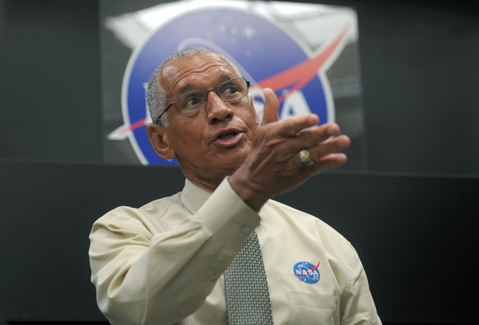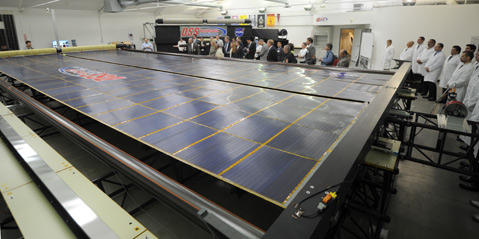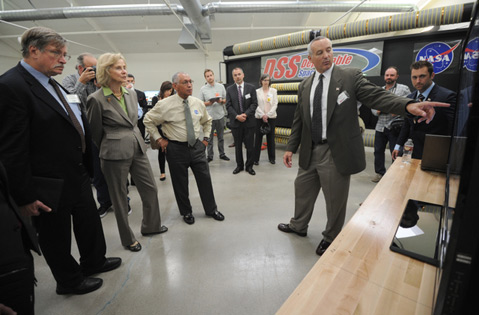NASA Chief Visits Goleta Company
Charles Bolden Tours Deployable Space Systems with Mars on His Mind

By 2025, NASA plans to lasso a small asteroid and park it in the moon’s orbit so astronauts can analyze the space rock for clues to how our solar system took shape. The Bradbury–esque mission was announced in April, and while funding and most of the required technology already exist, analysts are looking for better and cheaper ways to power the proposed spacecraft with a beefier solar-electric propulsion system that could also take people to Mars by 2030.
To that end, NASA is enlisting a number of private companies to build collapsible solar arrays big enough to run thrusters more than twice as powerful as those flying today. The competition for the lucrative contract is fierce, but two Goleta companies are in the running, one of which was visited by the head of NASA this Tuesday. Accompanied by Congressmember Lois Capps and a team of NASA scientists and engineers, Administrator Charles Bolden toured Deployable Space Systems (DSS) to see what the South Coast outfit has come up with.

He was presented with the Roll-Out Solar Array (ROSA), a big blanket of solar panels that elastically expands under its own strain energy. It’s rolled into a cylinder for launch and space travel, DSS president Brian Spence explained, as he pointed to a nearby 20-foot-by-45-foot, 25-kilowatt model, which slowly unfurls itself with the push of a button. The technology is cheaper, simpler, and more reliable than anything else out there, Spence argued. Bolden asked what would happen if one side of the wing became stuck during the roll-out and the whole array “gets catawampus.” Spence explained they’ve tested and ironed out such wrinkles.
Unlike the solar panels on our roof that convert only 10-15 percent of the sun’s energy into electricity, Spence said the ROSA’s gallium arsenide cells boast a 30 percent conversion rate. They’re “hellaciously expensive” he admitted — $250 a pop compared to the $2-$3 apiece for home models — but said his company was also developing a robotic system that could construct solar panels at perhaps half the cost. Should a single 25-kilowatt ROSA wing not provide enough voltage, it could be combined with others into a Mega-ROSA capable of delivering as much as 1 megawatt of power, explained Spence, while walking along a collapsible backbone structure with model ROSAs attached. (The current space station runs on 84 kilowatts of power provided by more than an acre of solar panels.)
Seemingly impressed, Bolden commended Spence and the DSS team, whose motto is “Innovate or Die!!” He said companies like DSS are laying the groundwork for the technology that will eventually take people to Mars, and that the jobs and industry that come out of such partnerships help NASA give answers when “constantly asked the question of ‘Why?’” Capps said she was happy to welcome Bolden to the Central Coast and to see DSS using tax dollars in a remarkable and productive way. “If we don’t do this, somebody will,” Capps said in reference to the Mars missions and other deep space ventures. “My fear,” Bolden said, “is if we don’t do this now, humanity will have missed an opportunity of a whole generation. So I don’t want to count on anyone else. I want us to do it.”

According to a 2013 Caltech study, NASA could spend up to $2.6 billion on the asteroid-capture mission by the end of 2025. Total funding for the project in 2014 is expected to reach $105 million, a fraction of NASA’s $17.7 billion spending plan for 2014. Of the insight and returns that could be expected from the asteroid hunt-and-peck operation, the Caltech study noted: “Experience gained via human expeditions to the [near-Earth asteroid] would transfer directly to follow-on international expeditions beyond the Earth-moon system: to other near-Earth asteroids, [the Mars moons] Phobos and Deimos, Mars and potentially someday to the main asteroid belt.”
DSS received a $4.9 million Small Business grant through NASA to work on ROSA, and the design will likely be selected for a next-phase space demonstration in the coming year alongside seven to 10 other companies, including Lockheed-Martin, Boeing, Loral, and so on. ATK’s Goleta facility received $6.9 million to come up with its own solar array — remarkably, the two Goodland firms were selected out of 10 organizations that competed for that 2012 round of funding — and has unveiled a motorized system that expands an accordion-packed blanket into the shape of a shallow umbrella. A similar ATK design powered the Mars Phoenix Lander mission in 2008.
NASA officials noted on Tuesday that ATK and DSS — which is comprised of many former ATK employees, including Spence — stand head and shoulders above the rest of the country and the world when it comes to array development. The synergy and local (but friendly) rivalry has perhaps fueled such rapid advances, they theorized. Nevertheless, Spence said he’s confident that ROSA will perform well in the next round of testing that DSS will prove why it has the edge in the South Coast space race. “We welcome the competition,” he said. “We’re in really good shape.”



